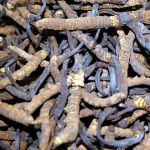| Common Name: |
Chinese Caterpillar Fungus |
| Other Names: |
Cordyceps, Dong Chong Xia Cao, Vegetable Caterpillar, Winter Worm Summer Grass. |
| Botanical Name: |
Cordyceps sinensis |
| Genus: |
Cordyceps |
| Family: |
Clavicipitaceae |
| Native Location: |
Foothills of the Himalayas in grassland above 3,353m (11,000ft). |
| Cultivation: |
Parasitic on moth larvae in the wild. May be cultivated on wheat. |
| Propagation: |
By spores on suitable host. |
| Harvest: |
Fungus is collected in early spring (as the snow melts) in the wild, or from a cultivated grain base, and dried for use as capsules, compressed slices, powder, or tinctures. |
| Height: |
4-8cm (1¼-3in) long. |
| Width: |
3mm (1/8 in) in diameter. |
| Hardiness: |
Hardy |
| Parts Used: |
Whole fungus (dong chong xia cao), Mycellium (main body of the fungus). |
| Properties: |
A sweet energy tonic for lungs and kidneys, and tranquilizer and muscle relaxant, controlling coughs and having anti-bacterial and anti-cancer effects. |
| Medicinal Uses: |
Internally for coughs, tuberculosis, conditions associated with kidney weakness (impotence, back pains, night sweats), menopausal problems, convalescence, and nasopharyngeal cancer.
To improve athletic performance, strengthen the immune system, reduce effects of aging, and promote longevity. |
| Typical Dose: |
A typical daily dose of cordyceps is approximately 3 gm of fermented cordyceps sinensis. |
| Possible Side Effects: |
There is little scientific information about cordycep's side effects. |
| Drug Interactions: |
| Taking cordyceps with these drugs may interfere with the action of the drug: |
| Cyclophosphamide, (Cytoxan, Neosar) |
Prednisolone, (Inflamase Forte, Pred Forte) |
| Taking cordyceps with this drugs may be harmful: |
| Fondaparinux, (Arixtra)—may increase the risk of bleeding or bruising. |
|
| Lab Test Alterations: |
Improved liver function in those with chronic Hepatitis B. |
| Culinary Uses: |
Fungus cooked with meat or fish in tonic soups and stews, and in rice porridge (China). Also an ingredient of ginseng elixir and other herbal tonics. |
| Bibliography: |
Encylopedia of Herbs by Deni Brown Copyright ©: 1995, 2001 Dorling Kindersley Limited pp 179-180
The Essential Herb-Drug-Vitamin Interaction Guide by Geo. T. Grossberg,MD & Barry Fox,PhD Copyright©2007 Barry Fox,PhD Pp. 163-164 |

